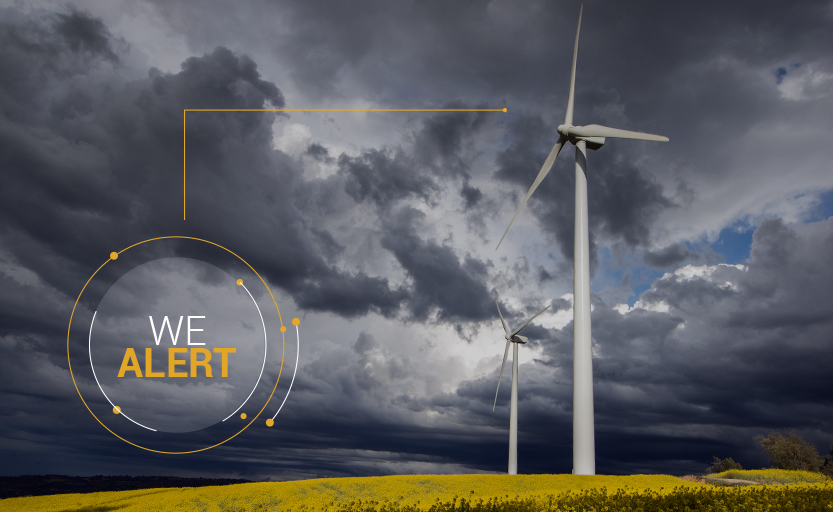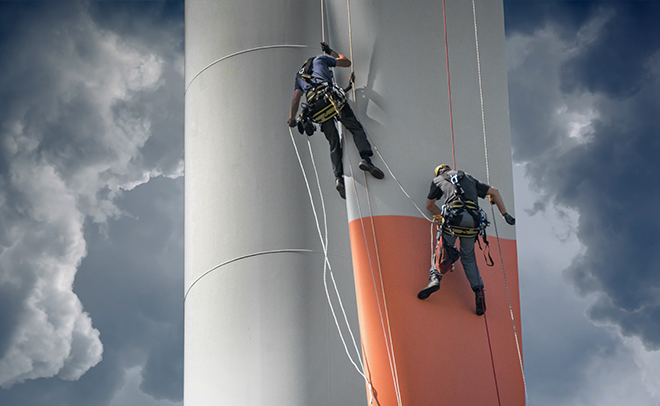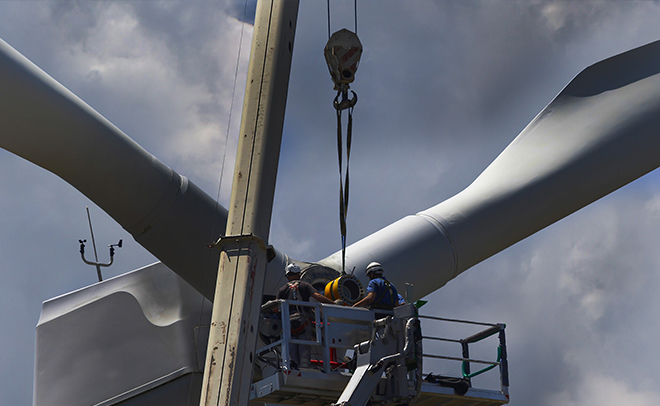The wind energy sector and inclement weather are an extremely dangerous combination. When an electrical storm approaches or forms near a wind farm, the main priority of the occupational safety technicians will undoubtedly be to guarantee the protection of their workers.
Employees who are working on a wind turbine will need to be alerted with enough time to get down from the wind towers and look for shelter. In order to ensure this process takes place in a staggered way without risk, the preventive measures taken by the technicians must be carried out several tens of minutes in advance.
People tend to think that the geographical location might make a wind farm be more or less prone to having this type of phenomena. However, the truth is that the location is not relevant, there will always be inclement weather and it is impossible to avoid it.
Approximately 2.000 thunderstorms are occurring at any given time around the world, with 100 lightning strikes on Earth every second. It is estimated, therefore, that there are around 4.000 daily storms and 9 million atmospheric discharges in just 24h. This huge proportion of lightning strikes are the cause of over 20.000 deaths and 240.000 injuries per year according to the NOAA (National Oceanic and Atmospheric Administration). This data is really alarming and should be taken into consideration when making preventive plans to avoid or minimize potential damage.
Wind turbines and lightning strikes
The wind energy sector is one of the most prone to lightning strikes due to its characteristics and locations. The employees usually work in open and isolated areas and sometimes in mountainous or offshore areas. These distinctive characteristics imply significantly longer evacuation times for staff, more than in other sectors.
The wind turbines are also located in elevated locations and are higher than the elements that surround them, so they end up being an ideal point of discharge for lightning strikes in these storms.
A direct lightning strike on a human can cause serious injury, including death. In this way, workers who suspended at high altitude while repairing or carrying out maintenance of the wind turbines may be affected by a direct or indirect lightning strike.
In the wind energy sector, conventional protection against direct lightning strikes cannot avoid certain damage, especially on blades, or ensure the safety of workers. Aplicaciones Tecnológicas has developed a local early alert expert system for thunderstorms, capable of identifying the formation and approach of electrical storms. It provides tens of minutes in advance and the alerts necessary to initiate preventive actions that minimize the risks.
Prevention measures against lightning strikes
Local storm detection can prevent labour risks related to lightning strikes. The implementation guide to determine the need for a lightning detection system, as well as the existing types, are described in the standard UNE-EN IEC 62793.
According to this standard, only detectors called “Class A” are effective for detecting the formation phase of electrical storms as they evaluate the preconditions necessary for the strike of lightning, which involve the phenomena associated with the electrification of the cloud. These types of detectors are also the only ones capable of detecting the final phase, or the dissipation, of the storm.
ATSTORM®, the expert local early warning system for storm risk prevention of Aplicaciones Tecnologicas, is able to detect all phases of the storm in real time. It belongs to the category of “Class A” detectors, therefore it is the ideal system for prevention of occupational risks caused by lightning strikes in the wind sector, which is so affected by this type of phenomenon.
Main advantages of the ATSTORM system
- Double sensing technology for more accurate detection:
The monitoring of the electrostatic field allows the detection of the formation of storms above the target area with tens of minutes in advance, as well as its dissipation. Local risk measurement allows the reduction of time of inactivity, preventing excessive duration, which results in important cost savings.
The monitoring of the electromagnetic field allows the detection of lightning storms approaching within a radius of 40 km of distance.
- Fully electronic, without mechanical moving parts: this prevents obstructions, wear, breakdown and maintenance.
- Uninterrupted monitoring: thanks to the Global M2M communication system (in the framework of IoT technologies) and the continuous sending of data through 2G/3G technology systems, the correct data collection and permanent supervision by a highly qualified team is ensured.
- IT infrastructure protected: devices, central servers and alarm devices are within a private network (VPN) in such way they are not visible via internet, ensuring total privacy and security in communications. The servers are also in redundant locations to ensure the proper functionality of the system.
- Expert system: continuous improvement of the algorithms, increasing its adaptation to the characteristics of its location and consequently the efficiency of the alarms.
- Flexible alarm management systems: it has an App with push alerts on mobile devices for real-time control for the risk of thunderstorms in your facilities.
Through a private web the user can visualize the state of risk of their facilities and obtain the historic data for future analysis.
In addition, it has an e-mail system and an automation system using remote relay modules that enable the activation/deactivation of alarm systems, sirens, signalling, etc. to provide full flexibility for the management of notifications in real time.
- Autonomous power supply system: the measuring stations come with solar panels for their total autonomy in addition to an integrated battery, as well as additional AC supply that acts as a backup system to ensure continuous operation.
An example of possible preventive measures
It is impossible to avoid storms, but it is possible to deploy temporary preventive actions to minimize risks for employees. A few examples of actions that would fit into a preventive plan during a lightning storm could be:
- Alert safety managers
- Suspend maintenance activities to safeguard the lives of operators.
- Evacuate workers to safe areas.
Atmospheric discharges in wind farms are a growing challenge and according to research carried out by IMIA (International Association of Engineering Insurers), it is confirmed that 20% of accidents in wind turbines in Denmark during the last 15 years have been caused by lightning strikes. Therefore, making use of a storm detector helps to reduce risks arising from this phenomenon.
If you are interested and you want to find out more about our product and protect your installations, do not hesitate to contact us, we will offer you a customised study.


